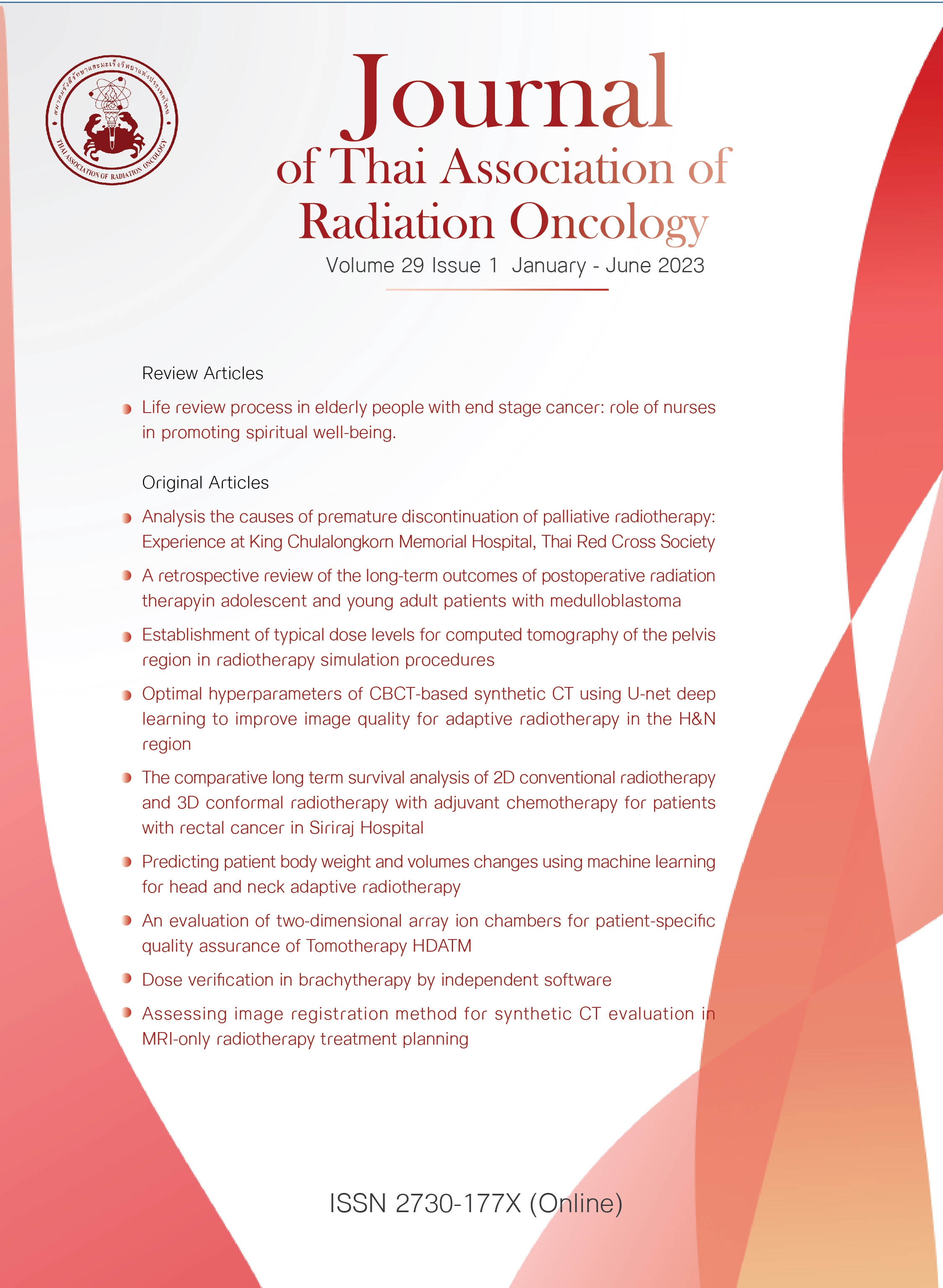Dose verification in brachytherapy by independent software
Keywords:
Brachytherapy, Treatment Planning System, Independent softwareAbstract
Background: Brachytherapy is a treatment method that delivers radiation directly into a specific site of the patient. It is necessary to control the quality of the Treatment Planning System and verify calculations using independent software to prevent errors that may occur in the planning.
Objective: To verify the radiation dose calculation at the reference point calculated from the treatment planning system compared to the independent software in cancer patients receiving brachytherapy. In addition, it also determined the benchmark for confidence limit in radiation dose calculation.
Materials and Methods: The Mobius Brachy independent software calibration was performed with IBA FC65-P Ionization Chamber 0.6 cc. The verification of the radiation dose calculation was performed by using the Oncentra MasterPlan version 4.5.3 treatment planning system compared with the independent software. This investigation is a retrospective study. The data were collected from patients receiving cancer treatment. The patients who were chosen as a sample group must use a defined type of applicator in the planning: Vaginal cylinder, Utrecht interstitial, and Fletcher for the total of 569 plans. The data were divided into groups following the type of applicator for finding the statistical values: maximum value, minimum value, average, and standard deviation. Then generate a confidence limit for use in an institution.
Results: The Mobius Brachy independent software demonstrated its results in the 0-percentage difference of calculated point doses compared with the ionization chamber. In verification of dose calculation, the results revealed that the Vaginal cylinder was -2.42%, the Utrecht interstitial was -1.07%, the Fletcher was -2.47% and all planning is -1.64%. The corresponding confidence limits were 4.44%, 5.32%, 3.27%, 5.31%, respectively.
Conclusion: The accuracy of radiation dose calculation at the reference point calculated from the treatment planning system compared to the independent software was within the range of ± 3%, and the overall confidence limit for the workers was not exceed 6%.
References
Poniewierza P, Panek G. Cervical Cancer Prophylaxis—State-of-the-Art and Perspectives. Healthc. 2022;10:1325-38.
Sung H, Ferlay J, Siegel RL, Laversanne M, Soerjomataram I, Jemal A, et al. Global Cancer Statistics 2020: GLOBOCAN Estimates of Incidence and Mortality Worldwide for 36 Cancers in 185 Countries. CA: A Cancer J. 2021;71:209-49.
Haie-Meder C, Potter R, Van Limbergen E, Briot E, De Brabandere M, Dimopoulos J, et al. Recommendations from Gynaecological (GYN) GEC-ESTRO Working Group (I): concepts and terms in 3D image based 3D treatment planning in cervix cancer brachytherapy with emphasis on MRI assessment of GTV and CTV. Radiother Oncol. 2005;74:235-45.
Elekta. Oncentra Brachy Comprehensive treatment planning for brachytherapy [Internet] 2017 [cited 2022 Aug 25]. Available from: https://www.elekta.com/products/brachytherapy/documents/Oncentra-Brachy-4.5-product-brochure.pdf
Sanklaa W. Independent software for dose verification in cervical cancer brachytherapy: Chulalongkorn University; 2014.
Rivard MJ, Coursey BM, DeWerd LA, Hanson WF, Huq MS, Ibbott GS, et al. Update of AAPM Task Group No. 43 Report: A revised AAPM protocol for brachytherapy dose calculations. Med Phys. 2004;31:633-74.
Ezzell GA, Burmeister JW, Dogan N, LoSasso TJ, Mechalakos JG, Mihailidis D, et al. IMRT commissioning: multiple institution planning and dosimetry comparisons, a report from AAPM Task Group 119. Med Phys. 2009;36:5359-73.
Mobius3D Instructions for Use. Varian Medical Systems; 2022
Safian NA, Abdullah NH, Abdullah R, Chiang CS. Verification of Oncentra brachytherapy planning using independent calculation. Journal of Physics: Conference Series. 2016;694:012003.
Carmona V, Perez-Calatayud J, Lliso F, Richart J, Ballester F, Pujades-Claumarchirant MC, et al. A program for the independent verification of brachytherapy planning system calculations. J Contemp Brachytherapy. 2010;2:129-33.
Bidmead M, Briot E, Burger J. A practical guide to quality control of brachytherapy equipment. European Society for Therapeutic Radiology and Oncology. ESTRO Booklet No.8. 2004.
Van Dyk J, Rosenwald J-C, Fraass B, Cramb J, Ionescu-Farca F, Sharpe MB. IAEA Technical Reports Series No. 430: Commissioning and quality assurance of computerized planning systems for radiation treatment of cancer. Med Phys. 2006;33.
Okamoto H, Aikawa A, Wakita A, Yoshio K, Murakami N, Nakamura S, et al. Dose error from deviation of dwell time and source position for high dose-rate 192Ir in remote afterloading system. J Radiat Res. 2014;55:780-7.
Downloads
Published
How to Cite
Issue
Section
License
Copyright (c) 2023 Thai Association of Radiation Oncology

This work is licensed under a Creative Commons Attribution-NonCommercial-NoDerivatives 4.0 International License.
บทความที่ได้รับการตีพิมพ์เป็นลิขสิทธิ์ของวารสารมะเร็งวิวัฒน์ ข้อความที่ปรากฏในบทความแต่ละเรื่องในวารสารวิชาการเล่มนี้เป็นความคิดเห็นส่วนตัวของผู้เขียนแต่ละท่านไม่เกี่ยวข้องกับ และบุคคลากรท่านอื่น ๆ ใน สมาคมฯ แต่อย่างใด ความรับผิดชอบองค์ประกอบทั้งหมดของบทความแต่ละเรื่องเป็นของผู้เขียนแต่ละท่าน หากมีความผิดพลาดใดๆ ผู้เขียนแต่ละท่านจะรับผิดชอบบทความของตนเองแต่ผู้เดียว




